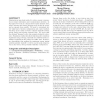Free Online Productivity Tools
i2Speak
i2Symbol
i2OCR
iTex2Img
iWeb2Print
iWeb2Shot
i2Type
iPdf2Split
iPdf2Merge
i2Bopomofo
i2Arabic
i2Style
i2Image
i2PDF
iLatex2Rtf
Sci2ools
EENERGY
2010
2010
Optimal sleep patterns for serving delay-tolerant jobs
Sleeping is an important method to reduce energy consumption in many information and communication systems. In this paper we focus on a typical server under dynamic load, where entering and leaving sleeping mode incurs an energy and a response time penalty. We seek to understand under what kind of system configuration and control method will sleep mode obtain a Pareto Optimal tradeoff between energy saving and average response time. We prove that the optimal “sleeping” policy has a simple hysteretic structure. Simulation results then show that this policy results in significant energy savings, especially for relatively delay insensitive applications and under low traffic load. However, we demonstrate that seeking the maximum energy saving presents another tradeoff: it drives up the peak temperature in the server, with potential reliability consequences. Categories and Subject Descriptors C.4 [Computer-Communication Networks]: Performance of systems—Modeling Techniques, Perfo...
| Added | 15 Aug 2010 |
| Updated | 15 Aug 2010 |
| Type | Conference |
| Year | 2010 |
| Where | EENERGY |
| Authors | Ioannis Kamitsos, Lachlan L. H. Andrew, Hongseok Kim, Mung Chiang |
Comments (0)

